An unknown episode from the biography of an architect Pompeo Ferrari connected with the reconstruction of Toruń after the siege of 1703
DOI:
https://doi.org/10.12775/SZiK.2014.003Keywords
Pompeo Ferrari, architecture, italian artists, baroque, Royal Prussia, 18th centuryAbstract
The paper is centered around a hitherto unknown letter written by a relatively well-known Roman architect working in Poland, Pompeo Ferrari, to the City Council of Toruń. The document, dated 27th January 1718, and preserved in the State Archives in Toruń, is a recommendation of his own person for the function of supervisor of planned construction works at the Town Hall and in a church, which can be identified as St. Mary’s, at the time in possession of Lutherans. The architect claims to have learned about the plans of restoring the buildings from an unidentified nobleman, who in turn obtained that information from Maciej Radomicki, general starost (administrator) of Greater Poland. Both buildings suffered substantial damage as a result of artillery fire during the siege laid by the Swedish army in September and October of 1703. The history of reconstruction of the Town Hall has already been the subject of considerable research, the most important published texts thereupon being the ones by Arthur Semrau and Eugeniusz Gąsiorowski. The renovation seems to have taken a long time, and was delivered in several stages, which mostly happened due to difficult financial situation of the municipality. In the first years after the bombing the building was only provided with a makeshift protection from further damage save for some ground floor chambers that were restored for trade purposes. The proper reconstruction started in 1722, and the first session of the City Council in the renewed hall took place as late as 1738. In contrast, the history of damage and rebuilding of St. Mary’s Church is barely discussed in existing literature. Until now, there was only some basic knowledge about new organ pipes being installed (1721) and undefined works on the turrets and the walls as well as in the interior being carried out (1722–1723). A further query in documents kept in the State Archives in Toruń proved that the preparations for the restoration of the temple, assessed as threatened with complete collapse, had been undertaken already in 1718 by appointing to these ends Jacob Ingber from Gdańsk, a master mason, and Johann Caspar Hindersin, a building engineer in service of count Alexander zu Dohna in Słobity (Schlobitten). Two architects vying for the task: Martin Friedrich von Creutz from Berlin, and Johann Kalckbrenner from Wrocław, were rejected. Hindersin arrived in Toruń soon in order to make a report on the church condition and draw up a project of a new roof truss. The letter by Pompeo Ferrari discussed here and presented in full in form of an appendix, is an interesting example of self-promotion practiced in order to obtain a profitable commission. Despite the fact, that the architect was eventually not employed by the City Council, the whole issue contributes to the knowledge of Ferrari’s biography and provides new information pertaining to the history of Toruń’s reconstruction after the Swedish siege of 1703.
Downloads
Published
How to Cite
Issue
Section
Stats
Number of views and downloads: 790
Number of citations: 0



